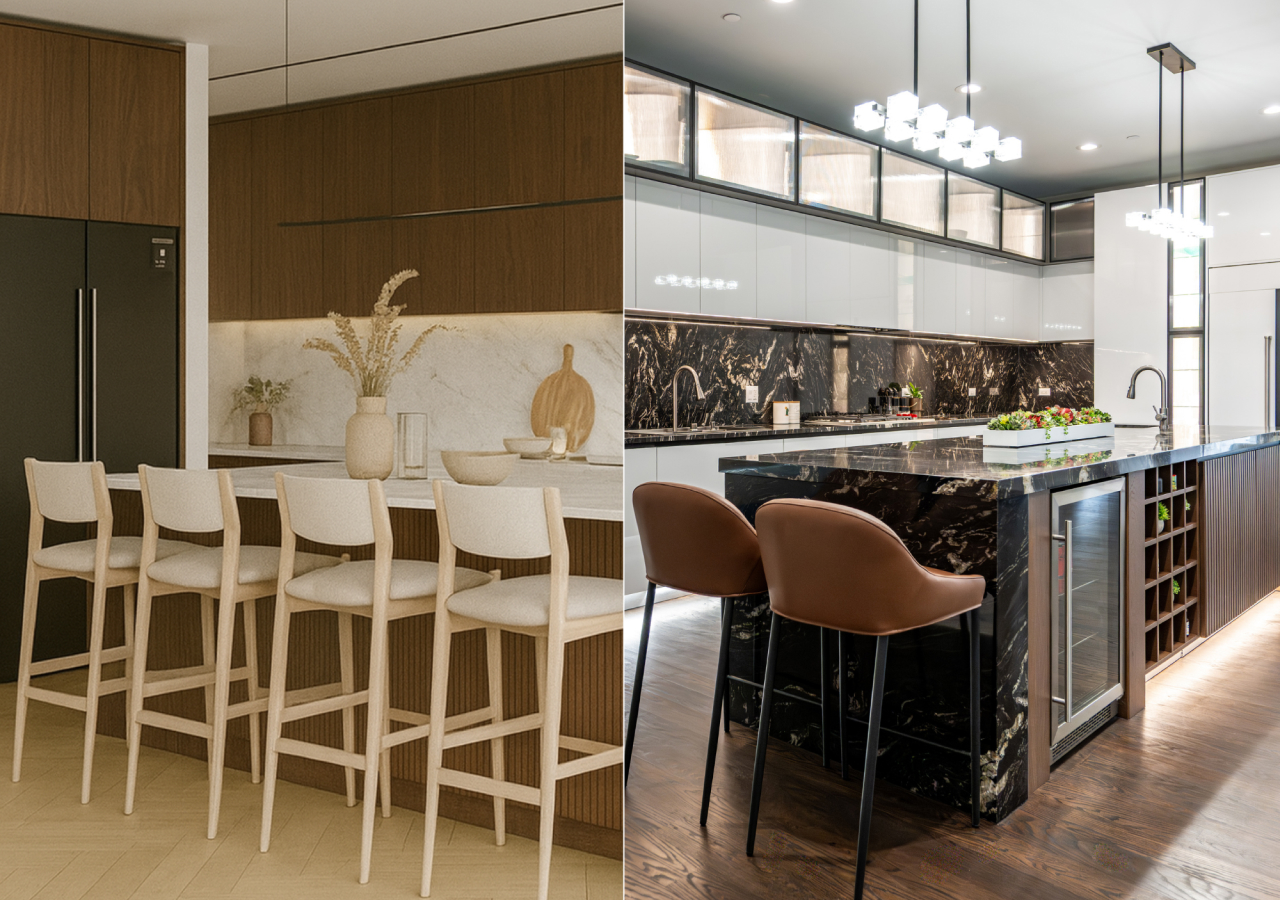For most homeowners, the kitchen is doing far more than it did a decade ago. It is where cooking, emails, kids’ homework, and casual dinners all collide, which makes clarity and organization just as important as cabinet color. Modern European-inspired kitchens respond to this by building order into the bones of the room: integrated appliances, tall storage, and internal organizers are treated as non-negotiable, so empty worktops and calm sightlines are possible even in small apartments.
This guide looks at modern vs contemporary kitchen design in a practical way. It explains what a modern kitchen is, what a contemporary kitchen is, where they overlap, how they differ, how styles like Japandi and Scandinavian fit in, and how to choose between them for your next modern kitchen remodel or contemporary kitchen renovation.
What is a Modern Kitchen?
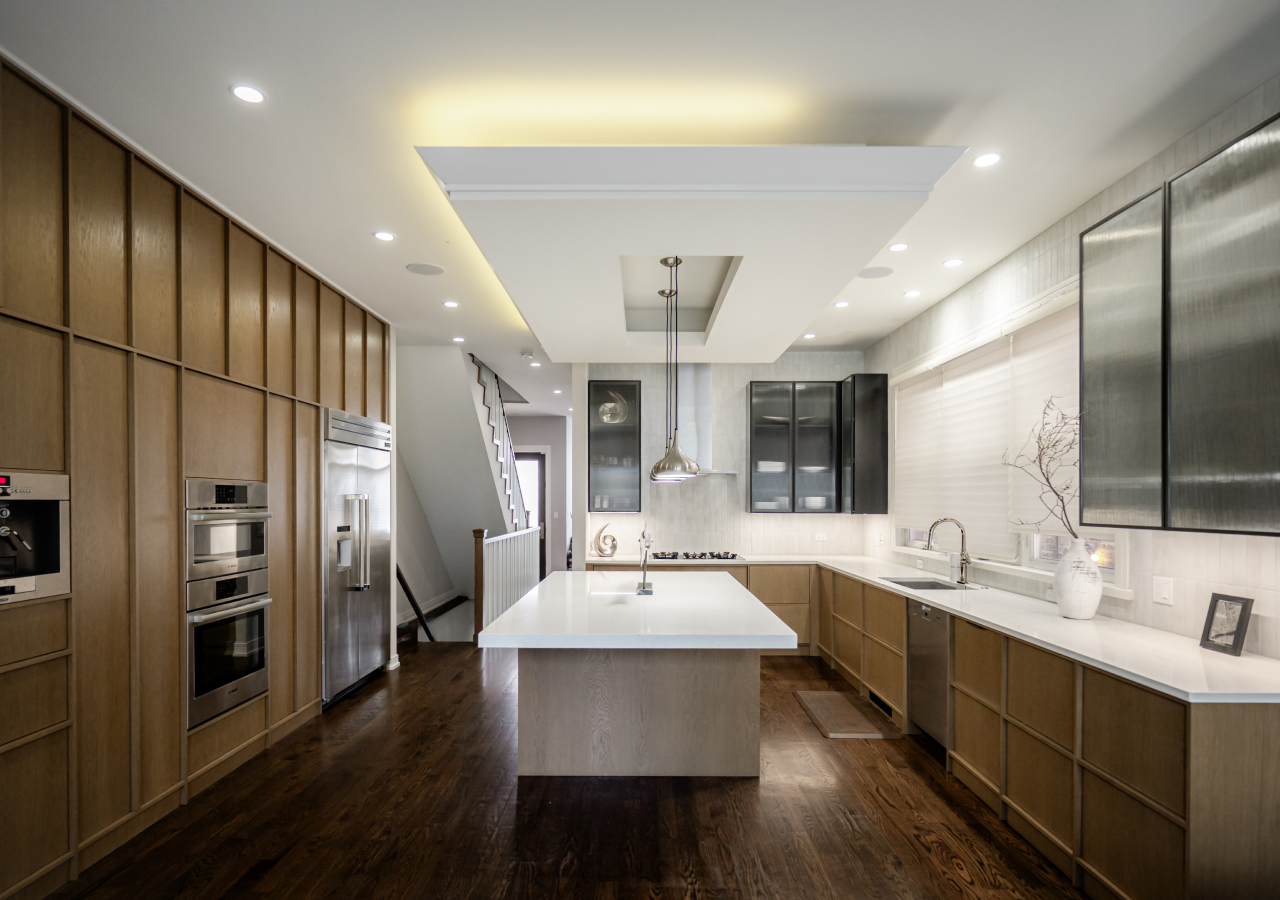
In a modern kitchen design, cabinets usually have flat fronts and very quiet hardware. Handleless systems or slim integrated pulls keep the doors reading as large, uninterrupted planes, rather than a grid of handles and knobs. Appliances are typically built in, so tall fridges, ovens, and dishwashers line up with cabinets rather than breaking the geometry. The layout is driven by workflow: sink, cooktop, and fridge are placed to minimize extra steps, and prep space is protected from traffic.
Color is deliberately restrained. Modern kitchen design leans on whites, beiges, soft greys, taupes, charcoal tones, and natural wood. A modern white kitchen might pair matte white fronts with light oak and a stone that quietly continues up the wall as a modern kitchen backsplash. Modern gray kitchen cabinets often sit in a tonal palette with slightly lighter walls and slightly darker worktops, so depth comes from subtle shifts rather than high-contrast moves.
Because the envelope is simple, storage has to do the heavy lifting. A modern kitchen renovation will often add tall modules with inner drawers, pull-out pantries, corner systems, and under-sink drawers so it is possible to keep counters clear and still store everything needed for daily cooking. This is what makes small modern kitchen ideas work: the room looks visually light but is quietly packed with function.
Key Features of Modern Kitchen Design

- Cabinet fronts and hardware: Modern kitchen cabinets typically have flat fronts and almost invisible hardware. True handleless systems, recessed channels, or slim integrated pulls keep the fronts smooth and continuous, which suits narrow walkways and compact layouts where every centimetre matters.
- Storage and organization: Inside, storage is layered rather than shallow. A single tall door can conceal inner drawers and pull-outs, deep drawers replace dark base shelves, and corner or under-sink systems reclaim awkward spaces. This is what lets a minimal modern kitchen stay practical in everyday use.
- Surfaces and palettes: Surfaces are usually matte and tactile. Countertops in stone or sintered materials often run up the wall as a simple modern kitchen backsplash. Within this framework, the mood can shift from a light modern white kitchen to a more grounded scheme with wood and stone, without leaving the modern language.
- Islands and layout: A modern kitchen island is planned as a working block, not just a decorative object. It usually combines storage, prep space, and casual dining in one element, often with drawers on one or both sides. In smaller homes, the same logic appears as a peninsula or slim island that still carries real storage and power.
What is a Contemporary Kitchen?

Contemporary kitchen design is basically “modern plus the present moment.” It still relies on flat fronts, integrated appliances, and efficient layouts, but it is more open to visual focal points. Contemporary kitchen ideas often borrow from loft interiors: open shelving, bistro-style seating, sculptural lighting, and a mix of smooth cabinets with textured stone or plaster walls. In an open-plan apartment, this helps the kitchen read as part of the living space instead of a separate room.
The overall shape of the room is still straightforward, and contemporary kitchen designs care just as much about workflow as modern ones. The difference is in how much personality you let onto the stage. Where a very strict modern space might keep everything quiet and tonal, a contemporary kitchen is more comfortable with strong stone veining, darker fixtures, and visible hardware, as long as the base structure remains simple.
Key Features of Contemporary Kitchen Design
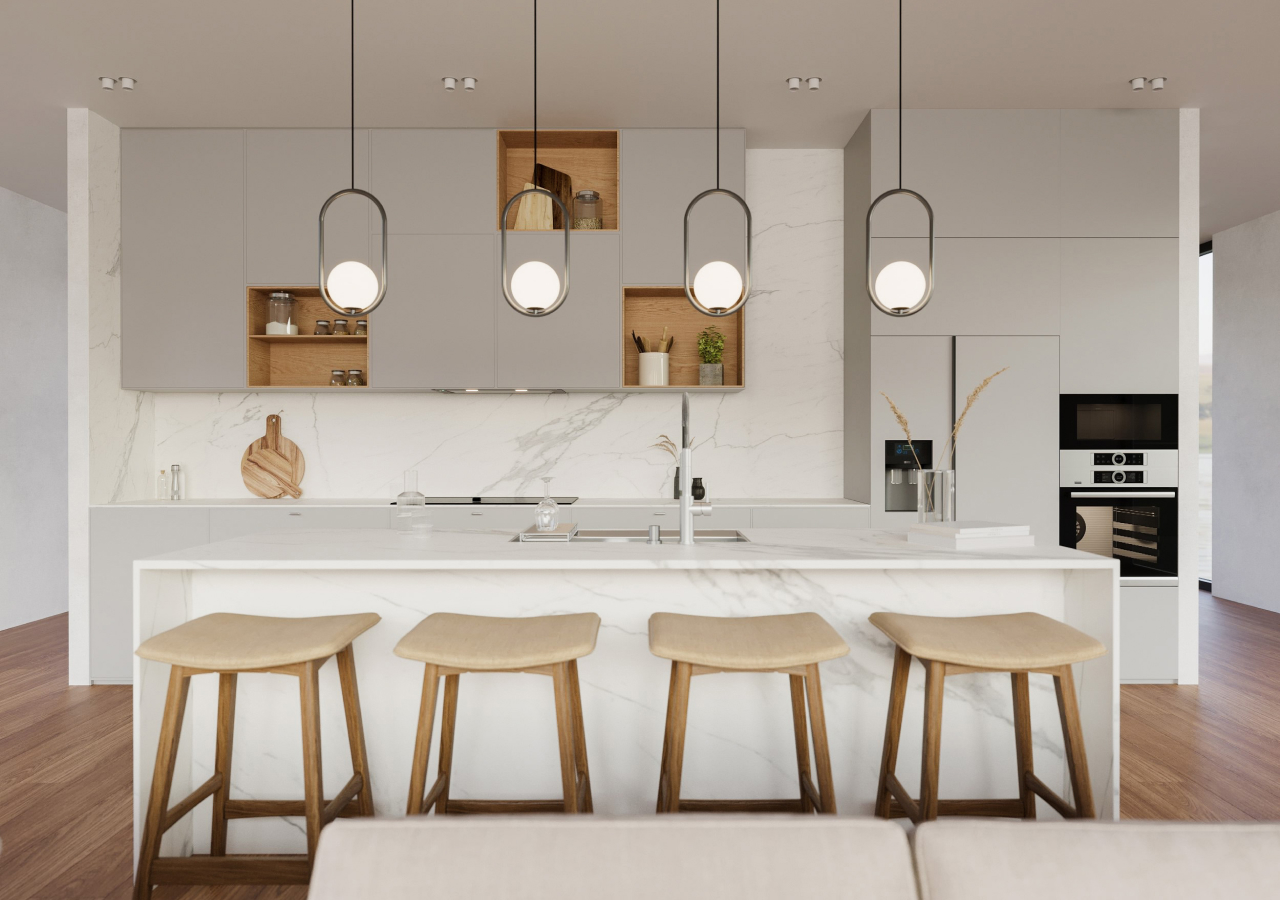
- Cabinet structure and profiles: Contemporary kitchens use flat-front, frameless cabinets much like modern ones, often with handleless tall units to keep sightlines calm. The difference is that they are more comfortable mixing in slim pulls or framed glass in selected areas, adding a bit of rhythm and detail.
- Color, contrast, and materials: Neutrals still form the base, but contemporary kitchen design uses contrast more freely. A contemporary white kitchen might meet a darker island and a strong stone slab, while contemporary gray kitchen cabinets often sit with warm wood, black fixtures, or metal shelving to create a loft-like mood.
- Open elements and display: Most storage is still closed, but contemporary kitchen ideas usually include a few intentional open zones. Floating shelves, a coffee niche, or a glass-fronted cabinet become curated moments that keep the room from feeling too strict, as long as they are edited and not overloaded.
- Islands, lighting, and backsplashes: A contemporary kitchen island often doubles as a statement piece, whether through a contrasting finish, lighter frame, or sculptural proportions. Lighting is more expressive, with pendants and linear fixtures layering task and ambience, and the contemporary kitchen backsplash is often treated as a feature through stone movement or textured tile.
Similarities Between Modern and Contemporary Kitchens

When you look under the styling, both modern and contemporary kitchen designs rely on the same core ideas. Both favor minimalist kitchen design with simple fronts, frameless construction, and layouts based on clear prep, cooking, and cleaning zones. Both depend on integrated appliances and internal organizers (pull-outs, inner drawers, corner systems, and tall modules) to keep countertops from turning into storage surfaces.
They also share a love of natural and nature-inspired materials. Scandinavian and Japandi kitchens, for example, show how wood, stone, and matte finishes can create spaces that feel calm and warm at the same time. Those projects can read as very modern or gently contemporary depending on how much contrast and open display you add, but the base structure is the same.
Differences Between Modern and Contemporary Kitchens
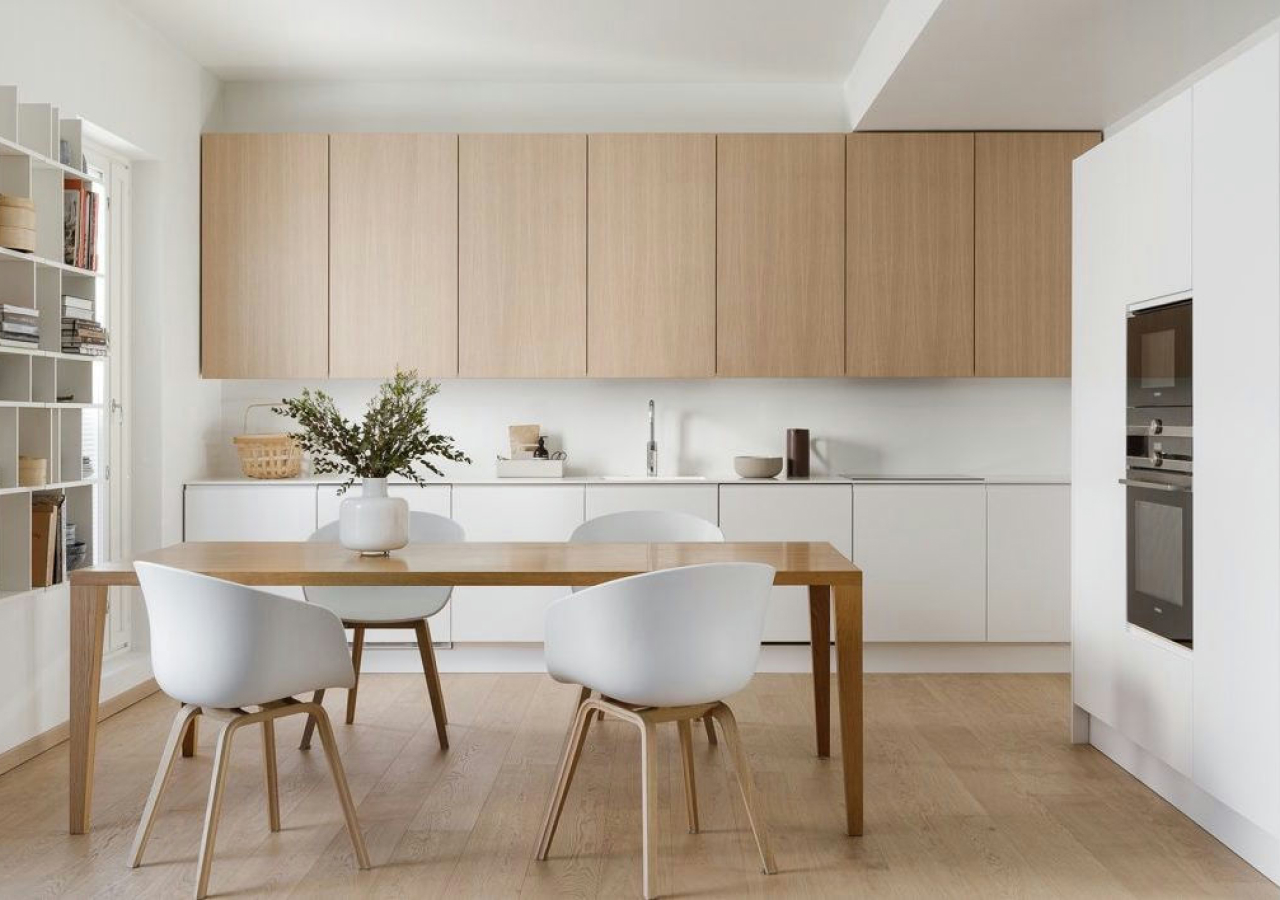
If you frame the question as modern vs contemporary kitchen design, you can think of modern as stable and contemporary as flexible. A modern kitchen sticks to flat or handleless fronts, tonal palettes, and minimal visible hardware, aiming to look almost the same ten years from now. A contemporary kitchen assumes that lighting, colors, and even some surfaces may change over time, while the core layout and cabinet system stay put. This is also where modern vs contemporary interior design shows up most clearly: modern is about long-term clarity; contemporary is about aligning with the current moment.
This is why modern vs contemporary interior design debates can feel more like a spectrum than a strict either–or choice. A modern contemporary kitchen draws from both ends: the stable structure and storage of modern design, plus the more expressive lighting and material contrasts associated with contemporary interiors.
How to Choose Between Modern and Contemporary Kitchens
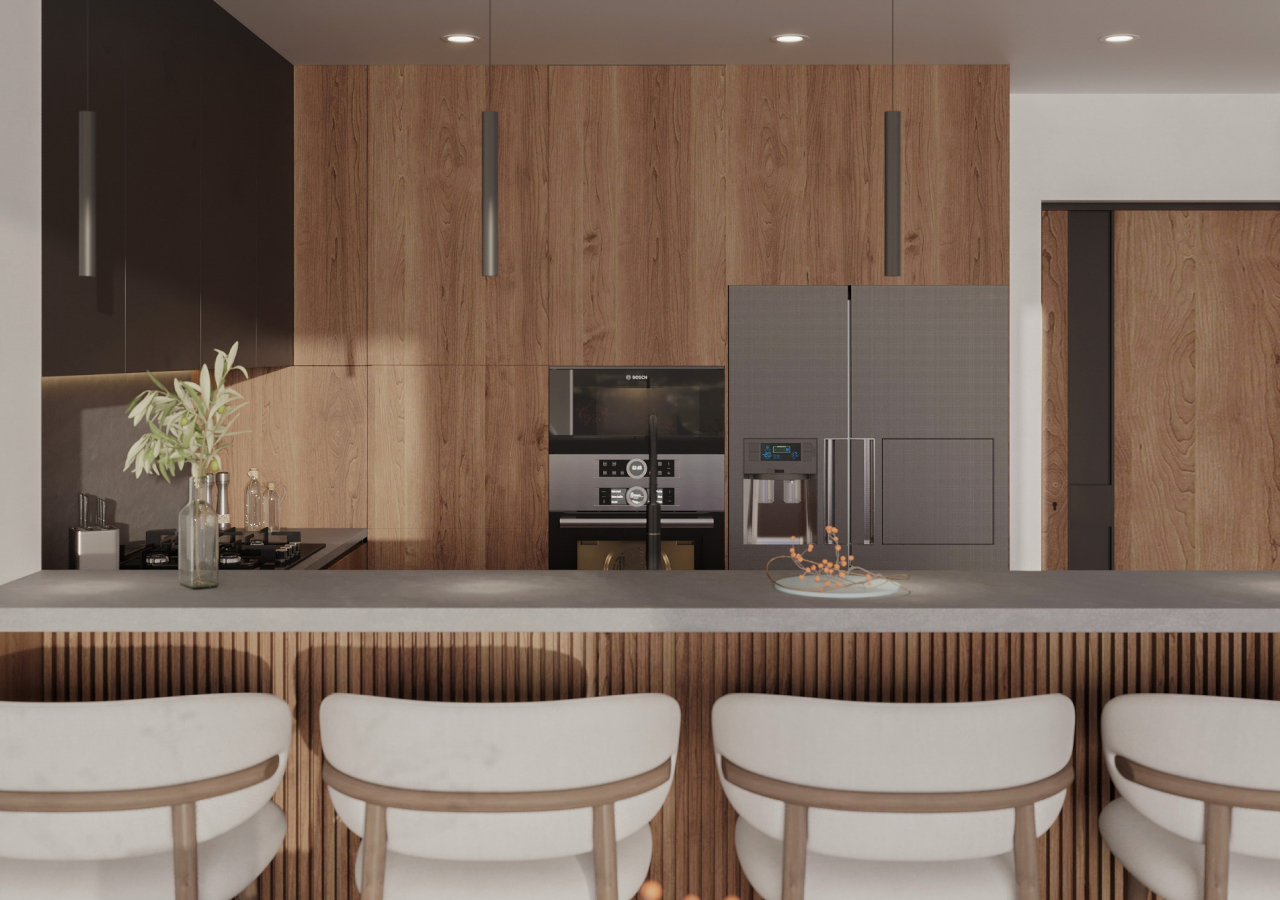
If you prefer to renovate once and then leave the room mostly unchanged, a modern kitchen design is usually the right fit. Flat or handleless fronts, tonal palettes, and minimal hardware create a neutral, long-term backdrop. A modern kitchen renovation planned this way will remain compatible with different furniture and decor phases without needing big surface changes.
If you enjoy updating colors, lighting, and materials every so often, contemporary kitchen design is more forgiving. In that case, treat the layout, cabinet system, and main appliances as long-term infrastructure, and let the contemporary kitchen island finish, contemporary kitchen backsplash, lighting, and a few open shelves be the flexible layers. Those elements are where contemporary kitchen remodel or contemporary kitchen renovation ideas deliver the biggest impact.
Architecture and lifestyle matter too. A compact, enclosed room often benefits from the visual discipline of a modern layout with strong storage, while a loft or wide open-plan space can easily handle the extra contrast and display of a contemporary kitchen. Either way, setting up even a basic temporary kitchen during renovation or a temporary kitchen during remodel gives you a chance to test how you actually cook and move, then refine your decisions before everything is built in.
Conclusion
A modern kitchen gives you a timeless, low-drama backdrop that relies on good storage, integrated appliances, and a restrained palette. A contemporary kitchen keeps those fundamentals but allows more contrast, visible texture, and expressive lighting, especially in open-plan and loft-style interiors. Both approaches can deliver a minimalist kitchen design that feels sophisticated and easy to live with when the layout and storage are planned with care.
If you want help translating these ideas into your own home, you can explore Corner Renovation’s modern kitchen collections. Compare real-world modern vs contemporary kitchen designs, and book a consultation to walk through layout options, storage solutions, and finishes tailored to your space.

